Holmes Institute: Advanced Financial Accounting (HA3011) Report
VerifiedAdded on 2022/11/14
|11
|3030
|4
Report
AI Summary
This report provides an in-depth analysis of the conceptual framework of accounting, focusing on its application to financial reporting. It begins by describing key accounting concepts such as the business entity, money measurement, and going concern concepts, illustrating them with examples from Tassal Group Limited's annual report. The report then delves into measurement issues, exploring different approaches like historical cost, current cost, and fair value, while highlighting inconsistencies and challenges in their application. The importance of relevance and representational faithfulness is discussed as crucial qualitative characteristics of financial information, examining the trade-offs between these criteria and their impact on decision-making. The report uses the annual report of Tassal Group Limited to illustrate the practical application of these concepts and frameworks. Overall, the report aims to provide a comprehensive understanding of the conceptual framework's role in shaping financial reporting practices.
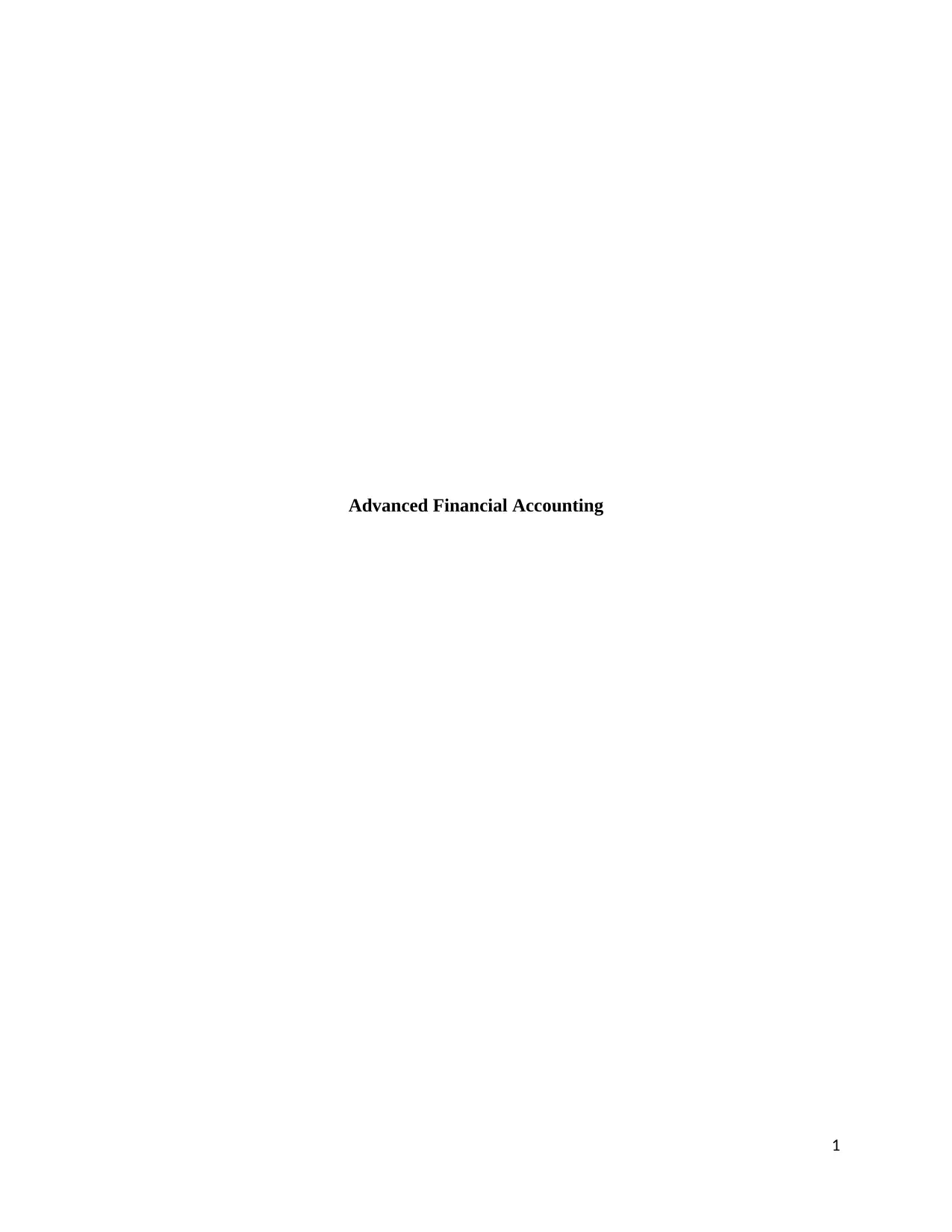
Advanced Financial Accounting
1
1
Paraphrase This Document
Need a fresh take? Get an instant paraphrase of this document with our AI Paraphraser
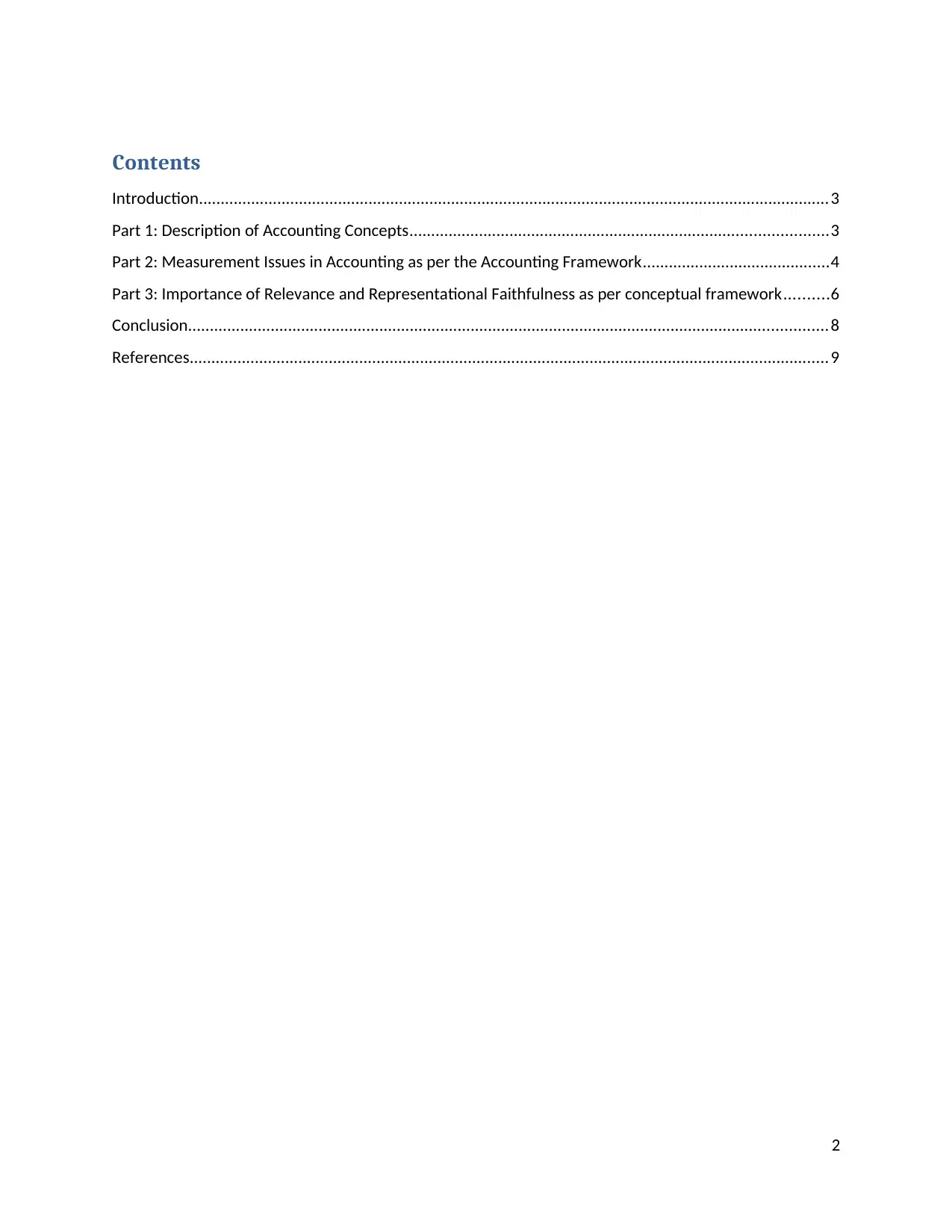
Contents
Introduction.................................................................................................................................................3
Part 1: Description of Accounting Concepts................................................................................................3
Part 2: Measurement Issues in Accounting as per the Accounting Framework...........................................4
Part 3: Importance of Relevance and Representational Faithfulness as per conceptual framework..........6
Conclusion...................................................................................................................................................8
References...................................................................................................................................................9
2
Introduction.................................................................................................................................................3
Part 1: Description of Accounting Concepts................................................................................................3
Part 2: Measurement Issues in Accounting as per the Accounting Framework...........................................4
Part 3: Importance of Relevance and Representational Faithfulness as per conceptual framework..........6
Conclusion...................................................................................................................................................8
References...................................................................................................................................................9
2
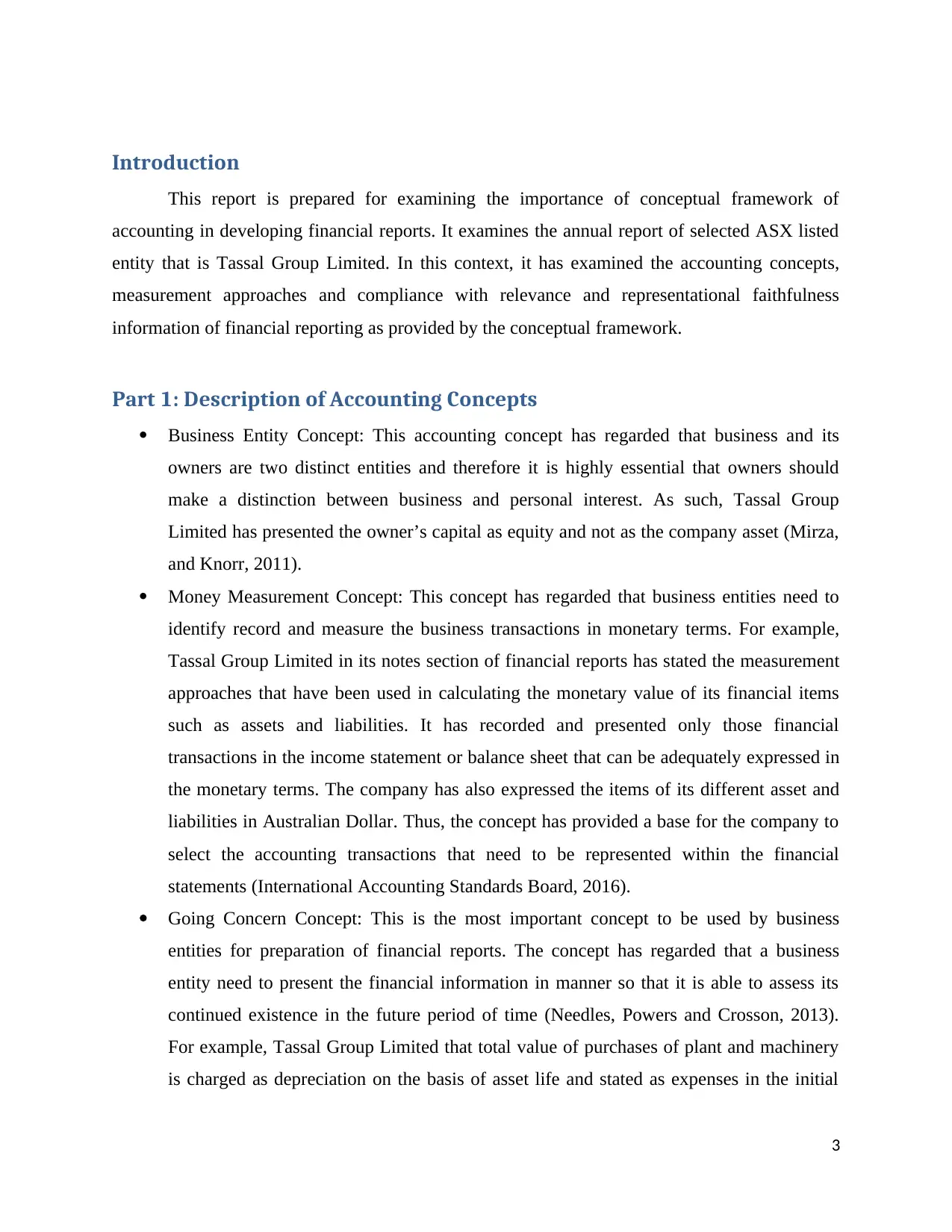
Introduction
This report is prepared for examining the importance of conceptual framework of
accounting in developing financial reports. It examines the annual report of selected ASX listed
entity that is Tassal Group Limited. In this context, it has examined the accounting concepts,
measurement approaches and compliance with relevance and representational faithfulness
information of financial reporting as provided by the conceptual framework.
Part 1: Description of Accounting Concepts
Business Entity Concept: This accounting concept has regarded that business and its
owners are two distinct entities and therefore it is highly essential that owners should
make a distinction between business and personal interest. As such, Tassal Group
Limited has presented the owner’s capital as equity and not as the company asset (Mirza,
and Knorr, 2011).
Money Measurement Concept: This concept has regarded that business entities need to
identify record and measure the business transactions in monetary terms. For example,
Tassal Group Limited in its notes section of financial reports has stated the measurement
approaches that have been used in calculating the monetary value of its financial items
such as assets and liabilities. It has recorded and presented only those financial
transactions in the income statement or balance sheet that can be adequately expressed in
the monetary terms. The company has also expressed the items of its different asset and
liabilities in Australian Dollar. Thus, the concept has provided a base for the company to
select the accounting transactions that need to be represented within the financial
statements (International Accounting Standards Board, 2016).
Going Concern Concept: This is the most important concept to be used by business
entities for preparation of financial reports. The concept has regarded that a business
entity need to present the financial information in manner so that it is able to assess its
continued existence in the future period of time (Needles, Powers and Crosson, 2013).
For example, Tassal Group Limited that total value of purchases of plant and machinery
is charged as depreciation on the basis of asset life and stated as expenses in the initial
3
This report is prepared for examining the importance of conceptual framework of
accounting in developing financial reports. It examines the annual report of selected ASX listed
entity that is Tassal Group Limited. In this context, it has examined the accounting concepts,
measurement approaches and compliance with relevance and representational faithfulness
information of financial reporting as provided by the conceptual framework.
Part 1: Description of Accounting Concepts
Business Entity Concept: This accounting concept has regarded that business and its
owners are two distinct entities and therefore it is highly essential that owners should
make a distinction between business and personal interest. As such, Tassal Group
Limited has presented the owner’s capital as equity and not as the company asset (Mirza,
and Knorr, 2011).
Money Measurement Concept: This concept has regarded that business entities need to
identify record and measure the business transactions in monetary terms. For example,
Tassal Group Limited in its notes section of financial reports has stated the measurement
approaches that have been used in calculating the monetary value of its financial items
such as assets and liabilities. It has recorded and presented only those financial
transactions in the income statement or balance sheet that can be adequately expressed in
the monetary terms. The company has also expressed the items of its different asset and
liabilities in Australian Dollar. Thus, the concept has provided a base for the company to
select the accounting transactions that need to be represented within the financial
statements (International Accounting Standards Board, 2016).
Going Concern Concept: This is the most important concept to be used by business
entities for preparation of financial reports. The concept has regarded that a business
entity need to present the financial information in manner so that it is able to assess its
continued existence in the future period of time (Needles, Powers and Crosson, 2013).
For example, Tassal Group Limited that total value of purchases of plant and machinery
is charged as depreciation on the basis of asset life and stated as expenses in the initial
3
⊘ This is a preview!⊘
Do you want full access?
Subscribe today to unlock all pages.

Trusted by 1+ million students worldwide
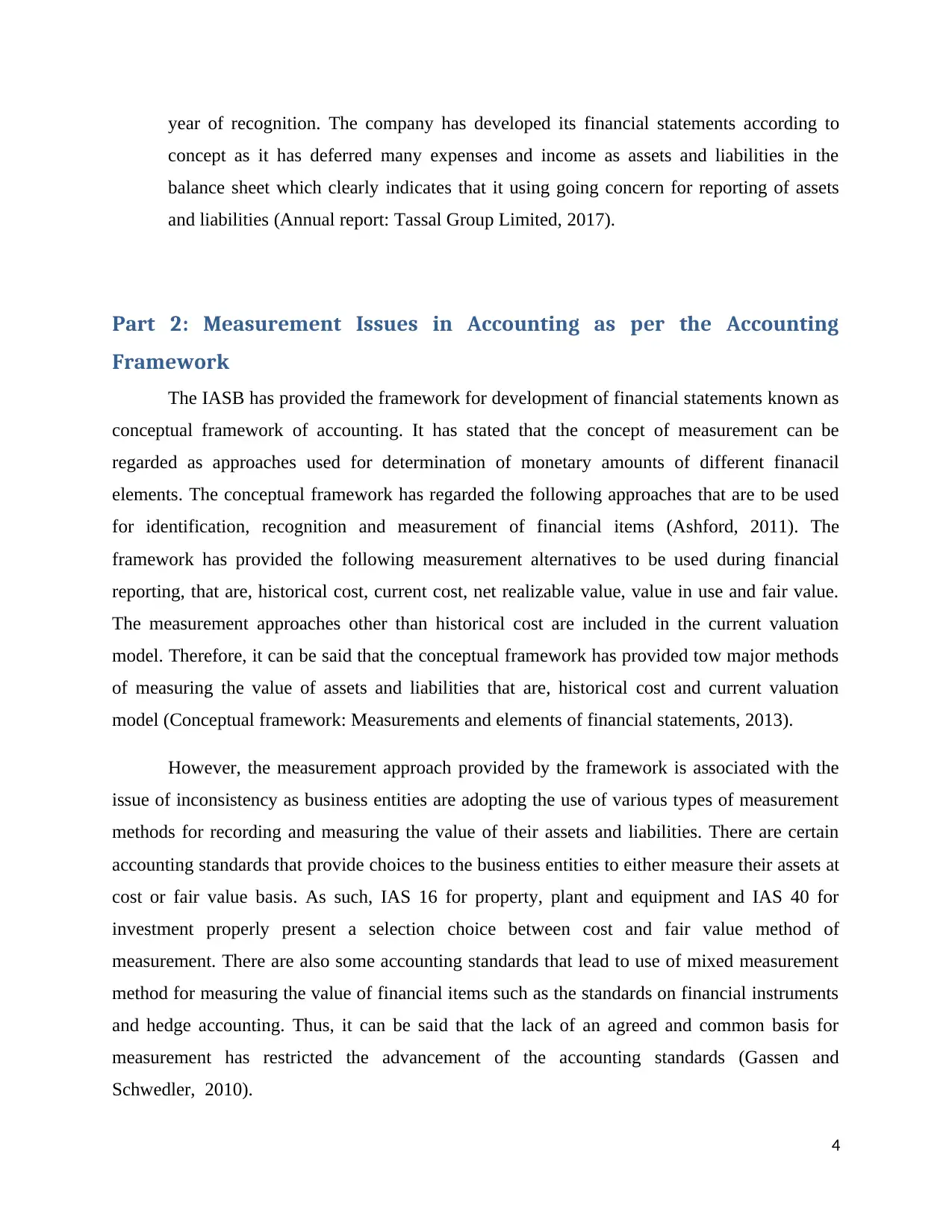
year of recognition. The company has developed its financial statements according to
concept as it has deferred many expenses and income as assets and liabilities in the
balance sheet which clearly indicates that it using going concern for reporting of assets
and liabilities (Annual report: Tassal Group Limited, 2017).
Part 2: Measurement Issues in Accounting as per the Accounting
Framework
The IASB has provided the framework for development of financial statements known as
conceptual framework of accounting. It has stated that the concept of measurement can be
regarded as approaches used for determination of monetary amounts of different finanacil
elements. The conceptual framework has regarded the following approaches that are to be used
for identification, recognition and measurement of financial items (Ashford, 2011). The
framework has provided the following measurement alternatives to be used during financial
reporting, that are, historical cost, current cost, net realizable value, value in use and fair value.
The measurement approaches other than historical cost are included in the current valuation
model. Therefore, it can be said that the conceptual framework has provided tow major methods
of measuring the value of assets and liabilities that are, historical cost and current valuation
model (Conceptual framework: Measurements and elements of financial statements, 2013).
However, the measurement approach provided by the framework is associated with the
issue of inconsistency as business entities are adopting the use of various types of measurement
methods for recording and measuring the value of their assets and liabilities. There are certain
accounting standards that provide choices to the business entities to either measure their assets at
cost or fair value basis. As such, IAS 16 for property, plant and equipment and IAS 40 for
investment properly present a selection choice between cost and fair value method of
measurement. There are also some accounting standards that lead to use of mixed measurement
method for measuring the value of financial items such as the standards on financial instruments
and hedge accounting. Thus, it can be said that the lack of an agreed and common basis for
measurement has restricted the advancement of the accounting standards (Gassen and
Schwedler, 2010).
4
concept as it has deferred many expenses and income as assets and liabilities in the
balance sheet which clearly indicates that it using going concern for reporting of assets
and liabilities (Annual report: Tassal Group Limited, 2017).
Part 2: Measurement Issues in Accounting as per the Accounting
Framework
The IASB has provided the framework for development of financial statements known as
conceptual framework of accounting. It has stated that the concept of measurement can be
regarded as approaches used for determination of monetary amounts of different finanacil
elements. The conceptual framework has regarded the following approaches that are to be used
for identification, recognition and measurement of financial items (Ashford, 2011). The
framework has provided the following measurement alternatives to be used during financial
reporting, that are, historical cost, current cost, net realizable value, value in use and fair value.
The measurement approaches other than historical cost are included in the current valuation
model. Therefore, it can be said that the conceptual framework has provided tow major methods
of measuring the value of assets and liabilities that are, historical cost and current valuation
model (Conceptual framework: Measurements and elements of financial statements, 2013).
However, the measurement approach provided by the framework is associated with the
issue of inconsistency as business entities are adopting the use of various types of measurement
methods for recording and measuring the value of their assets and liabilities. There are certain
accounting standards that provide choices to the business entities to either measure their assets at
cost or fair value basis. As such, IAS 16 for property, plant and equipment and IAS 40 for
investment properly present a selection choice between cost and fair value method of
measurement. There are also some accounting standards that lead to use of mixed measurement
method for measuring the value of financial items such as the standards on financial instruments
and hedge accounting. Thus, it can be said that the lack of an agreed and common basis for
measurement has restricted the advancement of the accounting standards (Gassen and
Schwedler, 2010).
4
Paraphrase This Document
Need a fresh take? Get an instant paraphrase of this document with our AI Paraphraser
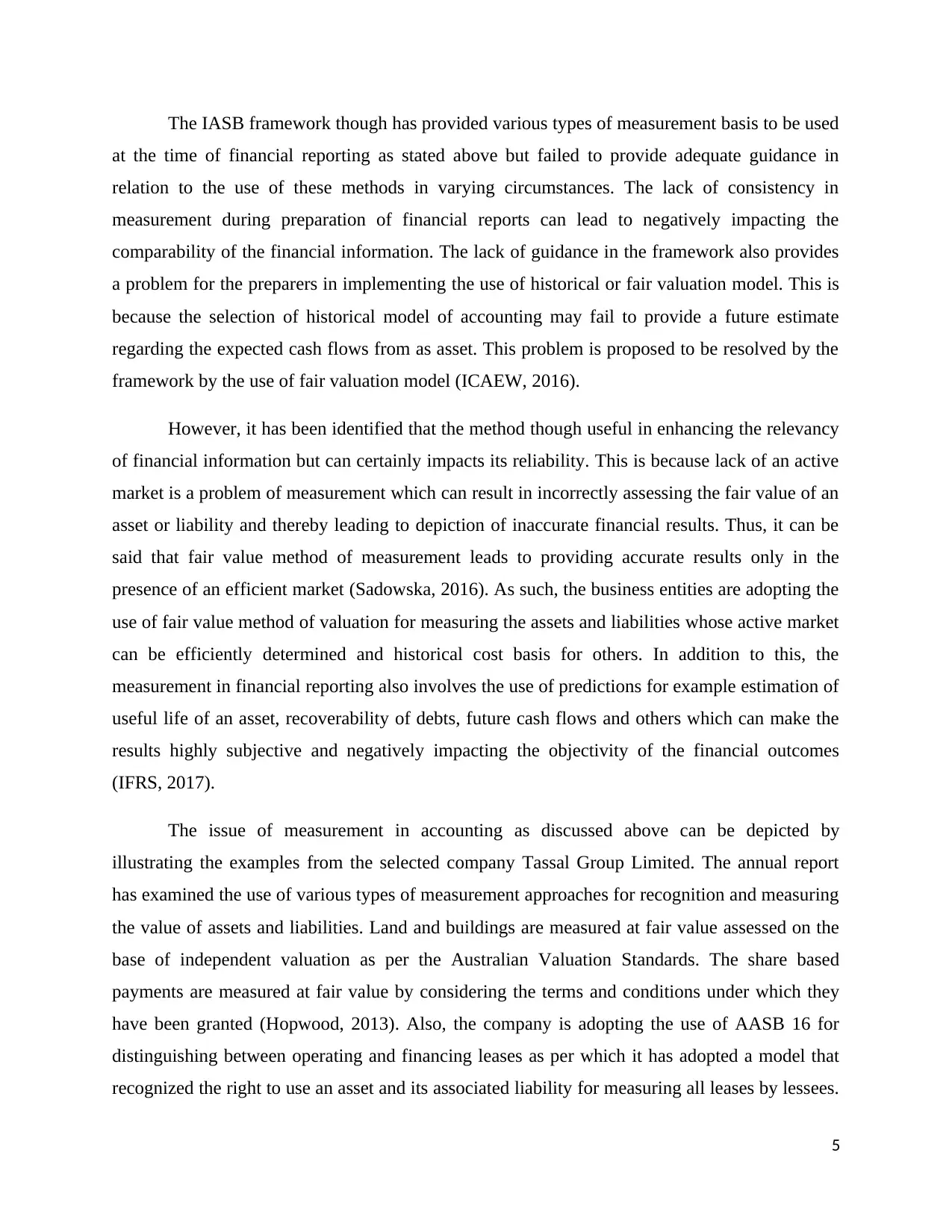
The IASB framework though has provided various types of measurement basis to be used
at the time of financial reporting as stated above but failed to provide adequate guidance in
relation to the use of these methods in varying circumstances. The lack of consistency in
measurement during preparation of financial reports can lead to negatively impacting the
comparability of the financial information. The lack of guidance in the framework also provides
a problem for the preparers in implementing the use of historical or fair valuation model. This is
because the selection of historical model of accounting may fail to provide a future estimate
regarding the expected cash flows from as asset. This problem is proposed to be resolved by the
framework by the use of fair valuation model (ICAEW, 2016).
However, it has been identified that the method though useful in enhancing the relevancy
of financial information but can certainly impacts its reliability. This is because lack of an active
market is a problem of measurement which can result in incorrectly assessing the fair value of an
asset or liability and thereby leading to depiction of inaccurate financial results. Thus, it can be
said that fair value method of measurement leads to providing accurate results only in the
presence of an efficient market (Sadowska, 2016). As such, the business entities are adopting the
use of fair value method of valuation for measuring the assets and liabilities whose active market
can be efficiently determined and historical cost basis for others. In addition to this, the
measurement in financial reporting also involves the use of predictions for example estimation of
useful life of an asset, recoverability of debts, future cash flows and others which can make the
results highly subjective and negatively impacting the objectivity of the financial outcomes
(IFRS, 2017).
The issue of measurement in accounting as discussed above can be depicted by
illustrating the examples from the selected company Tassal Group Limited. The annual report
has examined the use of various types of measurement approaches for recognition and measuring
the value of assets and liabilities. Land and buildings are measured at fair value assessed on the
base of independent valuation as per the Australian Valuation Standards. The share based
payments are measured at fair value by considering the terms and conditions under which they
have been granted (Hopwood, 2013). Also, the company is adopting the use of AASB 16 for
distinguishing between operating and financing leases as per which it has adopted a model that
recognized the right to use an asset and its associated liability for measuring all leases by lessees.
5
at the time of financial reporting as stated above but failed to provide adequate guidance in
relation to the use of these methods in varying circumstances. The lack of consistency in
measurement during preparation of financial reports can lead to negatively impacting the
comparability of the financial information. The lack of guidance in the framework also provides
a problem for the preparers in implementing the use of historical or fair valuation model. This is
because the selection of historical model of accounting may fail to provide a future estimate
regarding the expected cash flows from as asset. This problem is proposed to be resolved by the
framework by the use of fair valuation model (ICAEW, 2016).
However, it has been identified that the method though useful in enhancing the relevancy
of financial information but can certainly impacts its reliability. This is because lack of an active
market is a problem of measurement which can result in incorrectly assessing the fair value of an
asset or liability and thereby leading to depiction of inaccurate financial results. Thus, it can be
said that fair value method of measurement leads to providing accurate results only in the
presence of an efficient market (Sadowska, 2016). As such, the business entities are adopting the
use of fair value method of valuation for measuring the assets and liabilities whose active market
can be efficiently determined and historical cost basis for others. In addition to this, the
measurement in financial reporting also involves the use of predictions for example estimation of
useful life of an asset, recoverability of debts, future cash flows and others which can make the
results highly subjective and negatively impacting the objectivity of the financial outcomes
(IFRS, 2017).
The issue of measurement in accounting as discussed above can be depicted by
illustrating the examples from the selected company Tassal Group Limited. The annual report
has examined the use of various types of measurement approaches for recognition and measuring
the value of assets and liabilities. Land and buildings are measured at fair value assessed on the
base of independent valuation as per the Australian Valuation Standards. The share based
payments are measured at fair value by considering the terms and conditions under which they
have been granted (Hopwood, 2013). Also, the company is adopting the use of AASB 16 for
distinguishing between operating and financing leases as per which it has adopted a model that
recognized the right to use an asset and its associated liability for measuring all leases by lessees.
5
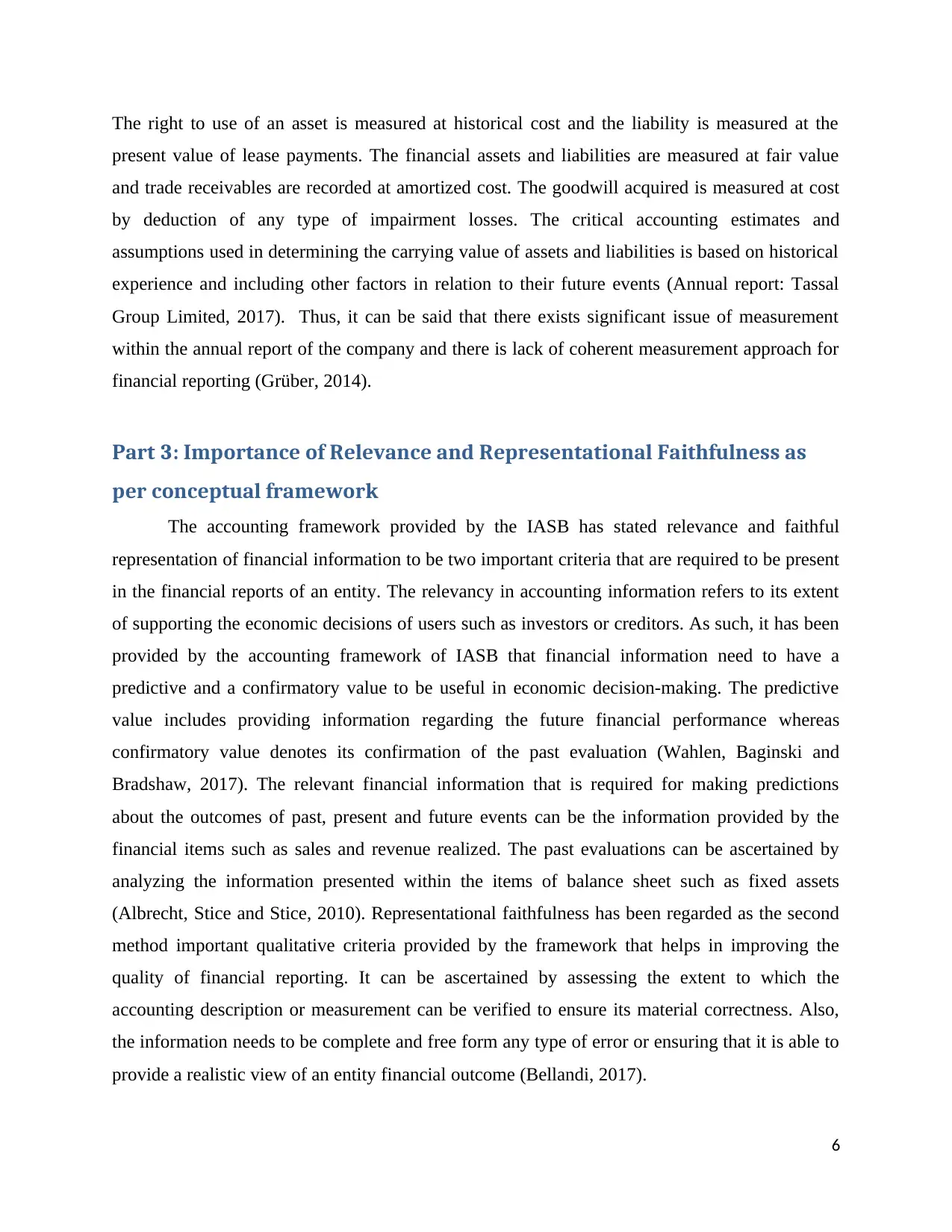
The right to use of an asset is measured at historical cost and the liability is measured at the
present value of lease payments. The financial assets and liabilities are measured at fair value
and trade receivables are recorded at amortized cost. The goodwill acquired is measured at cost
by deduction of any type of impairment losses. The critical accounting estimates and
assumptions used in determining the carrying value of assets and liabilities is based on historical
experience and including other factors in relation to their future events (Annual report: Tassal
Group Limited, 2017). Thus, it can be said that there exists significant issue of measurement
within the annual report of the company and there is lack of coherent measurement approach for
financial reporting (Grüber, 2014).
Part 3: Importance of Relevance and Representational Faithfulness as
per conceptual framework
The accounting framework provided by the IASB has stated relevance and faithful
representation of financial information to be two important criteria that are required to be present
in the financial reports of an entity. The relevancy in accounting information refers to its extent
of supporting the economic decisions of users such as investors or creditors. As such, it has been
provided by the accounting framework of IASB that financial information need to have a
predictive and a confirmatory value to be useful in economic decision-making. The predictive
value includes providing information regarding the future financial performance whereas
confirmatory value denotes its confirmation of the past evaluation (Wahlen, Baginski and
Bradshaw, 2017). The relevant financial information that is required for making predictions
about the outcomes of past, present and future events can be the information provided by the
financial items such as sales and revenue realized. The past evaluations can be ascertained by
analyzing the information presented within the items of balance sheet such as fixed assets
(Albrecht, Stice and Stice, 2010). Representational faithfulness has been regarded as the second
method important qualitative criteria provided by the framework that helps in improving the
quality of financial reporting. It can be ascertained by assessing the extent to which the
accounting description or measurement can be verified to ensure its material correctness. Also,
the information needs to be complete and free form any type of error or ensuring that it is able to
provide a realistic view of an entity financial outcome (Bellandi, 2017).
6
present value of lease payments. The financial assets and liabilities are measured at fair value
and trade receivables are recorded at amortized cost. The goodwill acquired is measured at cost
by deduction of any type of impairment losses. The critical accounting estimates and
assumptions used in determining the carrying value of assets and liabilities is based on historical
experience and including other factors in relation to their future events (Annual report: Tassal
Group Limited, 2017). Thus, it can be said that there exists significant issue of measurement
within the annual report of the company and there is lack of coherent measurement approach for
financial reporting (Grüber, 2014).
Part 3: Importance of Relevance and Representational Faithfulness as
per conceptual framework
The accounting framework provided by the IASB has stated relevance and faithful
representation of financial information to be two important criteria that are required to be present
in the financial reports of an entity. The relevancy in accounting information refers to its extent
of supporting the economic decisions of users such as investors or creditors. As such, it has been
provided by the accounting framework of IASB that financial information need to have a
predictive and a confirmatory value to be useful in economic decision-making. The predictive
value includes providing information regarding the future financial performance whereas
confirmatory value denotes its confirmation of the past evaluation (Wahlen, Baginski and
Bradshaw, 2017). The relevant financial information that is required for making predictions
about the outcomes of past, present and future events can be the information provided by the
financial items such as sales and revenue realized. The past evaluations can be ascertained by
analyzing the information presented within the items of balance sheet such as fixed assets
(Albrecht, Stice and Stice, 2010). Representational faithfulness has been regarded as the second
method important qualitative criteria provided by the framework that helps in improving the
quality of financial reporting. It can be ascertained by assessing the extent to which the
accounting description or measurement can be verified to ensure its material correctness. Also,
the information needs to be complete and free form any type of error or ensuring that it is able to
provide a realistic view of an entity financial outcome (Bellandi, 2017).
6
⊘ This is a preview!⊘
Do you want full access?
Subscribe today to unlock all pages.

Trusted by 1+ million students worldwide
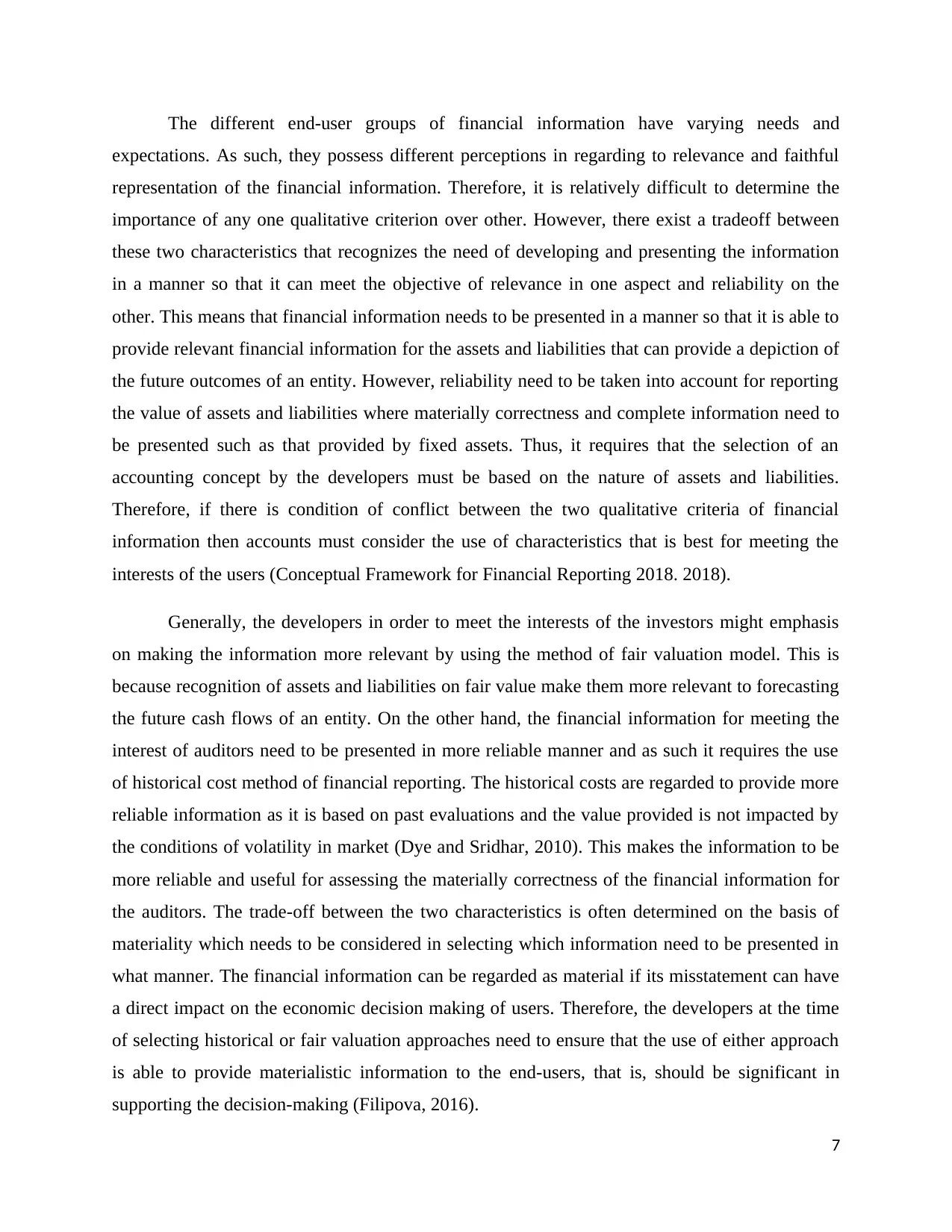
The different end-user groups of financial information have varying needs and
expectations. As such, they possess different perceptions in regarding to relevance and faithful
representation of the financial information. Therefore, it is relatively difficult to determine the
importance of any one qualitative criterion over other. However, there exist a tradeoff between
these two characteristics that recognizes the need of developing and presenting the information
in a manner so that it can meet the objective of relevance in one aspect and reliability on the
other. This means that financial information needs to be presented in a manner so that it is able to
provide relevant financial information for the assets and liabilities that can provide a depiction of
the future outcomes of an entity. However, reliability need to be taken into account for reporting
the value of assets and liabilities where materially correctness and complete information need to
be presented such as that provided by fixed assets. Thus, it requires that the selection of an
accounting concept by the developers must be based on the nature of assets and liabilities.
Therefore, if there is condition of conflict between the two qualitative criteria of financial
information then accounts must consider the use of characteristics that is best for meeting the
interests of the users (Conceptual Framework for Financial Reporting 2018. 2018).
Generally, the developers in order to meet the interests of the investors might emphasis
on making the information more relevant by using the method of fair valuation model. This is
because recognition of assets and liabilities on fair value make them more relevant to forecasting
the future cash flows of an entity. On the other hand, the financial information for meeting the
interest of auditors need to be presented in more reliable manner and as such it requires the use
of historical cost method of financial reporting. The historical costs are regarded to provide more
reliable information as it is based on past evaluations and the value provided is not impacted by
the conditions of volatility in market (Dye and Sridhar, 2010). This makes the information to be
more reliable and useful for assessing the materially correctness of the financial information for
the auditors. The trade-off between the two characteristics is often determined on the basis of
materiality which needs to be considered in selecting which information need to be presented in
what manner. The financial information can be regarded as material if its misstatement can have
a direct impact on the economic decision making of users. Therefore, the developers at the time
of selecting historical or fair valuation approaches need to ensure that the use of either approach
is able to provide materialistic information to the end-users, that is, should be significant in
supporting the decision-making (Filipova, 2016).
7
expectations. As such, they possess different perceptions in regarding to relevance and faithful
representation of the financial information. Therefore, it is relatively difficult to determine the
importance of any one qualitative criterion over other. However, there exist a tradeoff between
these two characteristics that recognizes the need of developing and presenting the information
in a manner so that it can meet the objective of relevance in one aspect and reliability on the
other. This means that financial information needs to be presented in a manner so that it is able to
provide relevant financial information for the assets and liabilities that can provide a depiction of
the future outcomes of an entity. However, reliability need to be taken into account for reporting
the value of assets and liabilities where materially correctness and complete information need to
be presented such as that provided by fixed assets. Thus, it requires that the selection of an
accounting concept by the developers must be based on the nature of assets and liabilities.
Therefore, if there is condition of conflict between the two qualitative criteria of financial
information then accounts must consider the use of characteristics that is best for meeting the
interests of the users (Conceptual Framework for Financial Reporting 2018. 2018).
Generally, the developers in order to meet the interests of the investors might emphasis
on making the information more relevant by using the method of fair valuation model. This is
because recognition of assets and liabilities on fair value make them more relevant to forecasting
the future cash flows of an entity. On the other hand, the financial information for meeting the
interest of auditors need to be presented in more reliable manner and as such it requires the use
of historical cost method of financial reporting. The historical costs are regarded to provide more
reliable information as it is based on past evaluations and the value provided is not impacted by
the conditions of volatility in market (Dye and Sridhar, 2010). This makes the information to be
more reliable and useful for assessing the materially correctness of the financial information for
the auditors. The trade-off between the two characteristics is often determined on the basis of
materiality which needs to be considered in selecting which information need to be presented in
what manner. The financial information can be regarded as material if its misstatement can have
a direct impact on the economic decision making of users. Therefore, the developers at the time
of selecting historical or fair valuation approaches need to ensure that the use of either approach
is able to provide materialistic information to the end-users, that is, should be significant in
supporting the decision-making (Filipova, 2016).
7
Paraphrase This Document
Need a fresh take? Get an instant paraphrase of this document with our AI Paraphraser
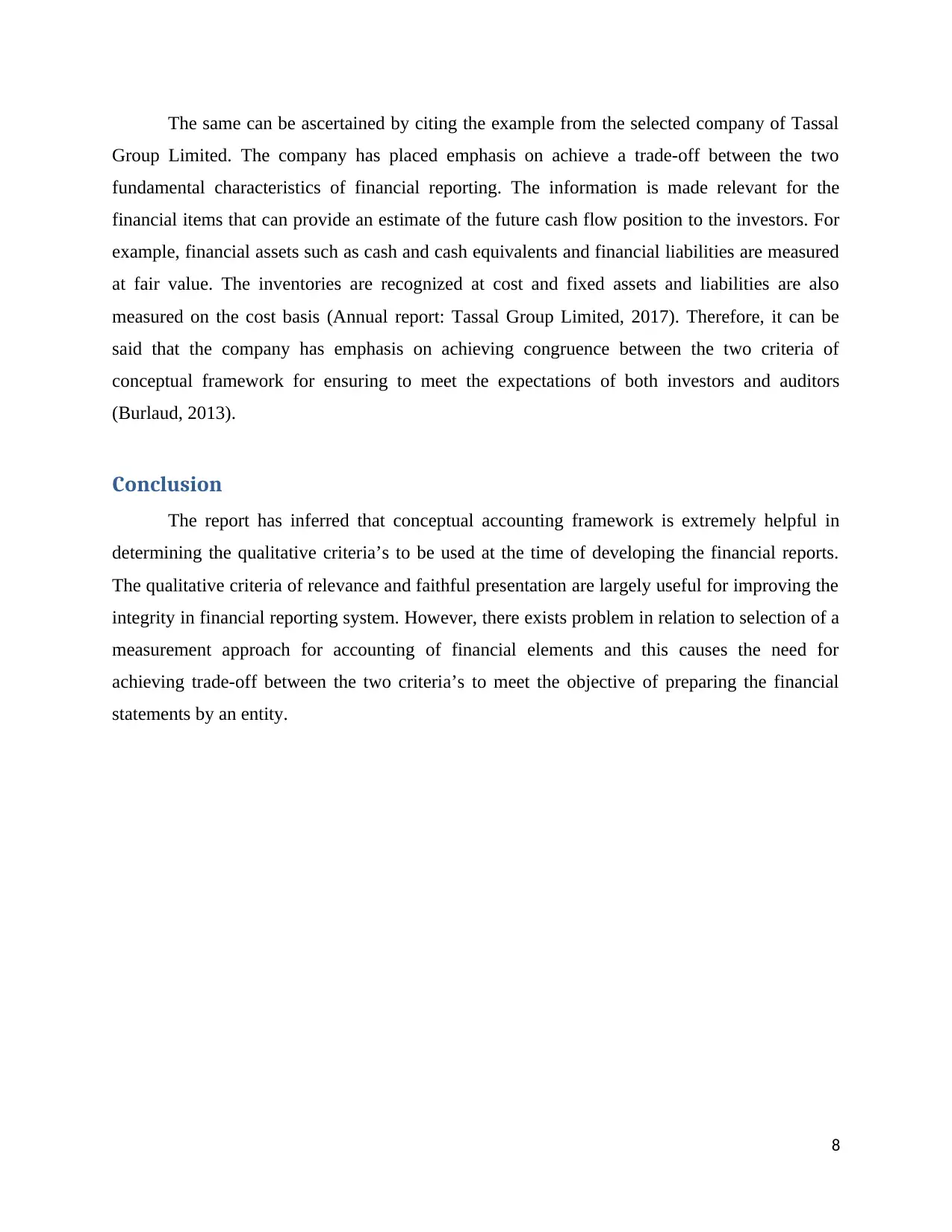
The same can be ascertained by citing the example from the selected company of Tassal
Group Limited. The company has placed emphasis on achieve a trade-off between the two
fundamental characteristics of financial reporting. The information is made relevant for the
financial items that can provide an estimate of the future cash flow position to the investors. For
example, financial assets such as cash and cash equivalents and financial liabilities are measured
at fair value. The inventories are recognized at cost and fixed assets and liabilities are also
measured on the cost basis (Annual report: Tassal Group Limited, 2017). Therefore, it can be
said that the company has emphasis on achieving congruence between the two criteria of
conceptual framework for ensuring to meet the expectations of both investors and auditors
(Burlaud, 2013).
Conclusion
The report has inferred that conceptual accounting framework is extremely helpful in
determining the qualitative criteria’s to be used at the time of developing the financial reports.
The qualitative criteria of relevance and faithful presentation are largely useful for improving the
integrity in financial reporting system. However, there exists problem in relation to selection of a
measurement approach for accounting of financial elements and this causes the need for
achieving trade-off between the two criteria’s to meet the objective of preparing the financial
statements by an entity.
8
Group Limited. The company has placed emphasis on achieve a trade-off between the two
fundamental characteristics of financial reporting. The information is made relevant for the
financial items that can provide an estimate of the future cash flow position to the investors. For
example, financial assets such as cash and cash equivalents and financial liabilities are measured
at fair value. The inventories are recognized at cost and fixed assets and liabilities are also
measured on the cost basis (Annual report: Tassal Group Limited, 2017). Therefore, it can be
said that the company has emphasis on achieving congruence between the two criteria of
conceptual framework for ensuring to meet the expectations of both investors and auditors
(Burlaud, 2013).
Conclusion
The report has inferred that conceptual accounting framework is extremely helpful in
determining the qualitative criteria’s to be used at the time of developing the financial reports.
The qualitative criteria of relevance and faithful presentation are largely useful for improving the
integrity in financial reporting system. However, there exists problem in relation to selection of a
measurement approach for accounting of financial elements and this causes the need for
achieving trade-off between the two criteria’s to meet the objective of preparing the financial
statements by an entity.
8
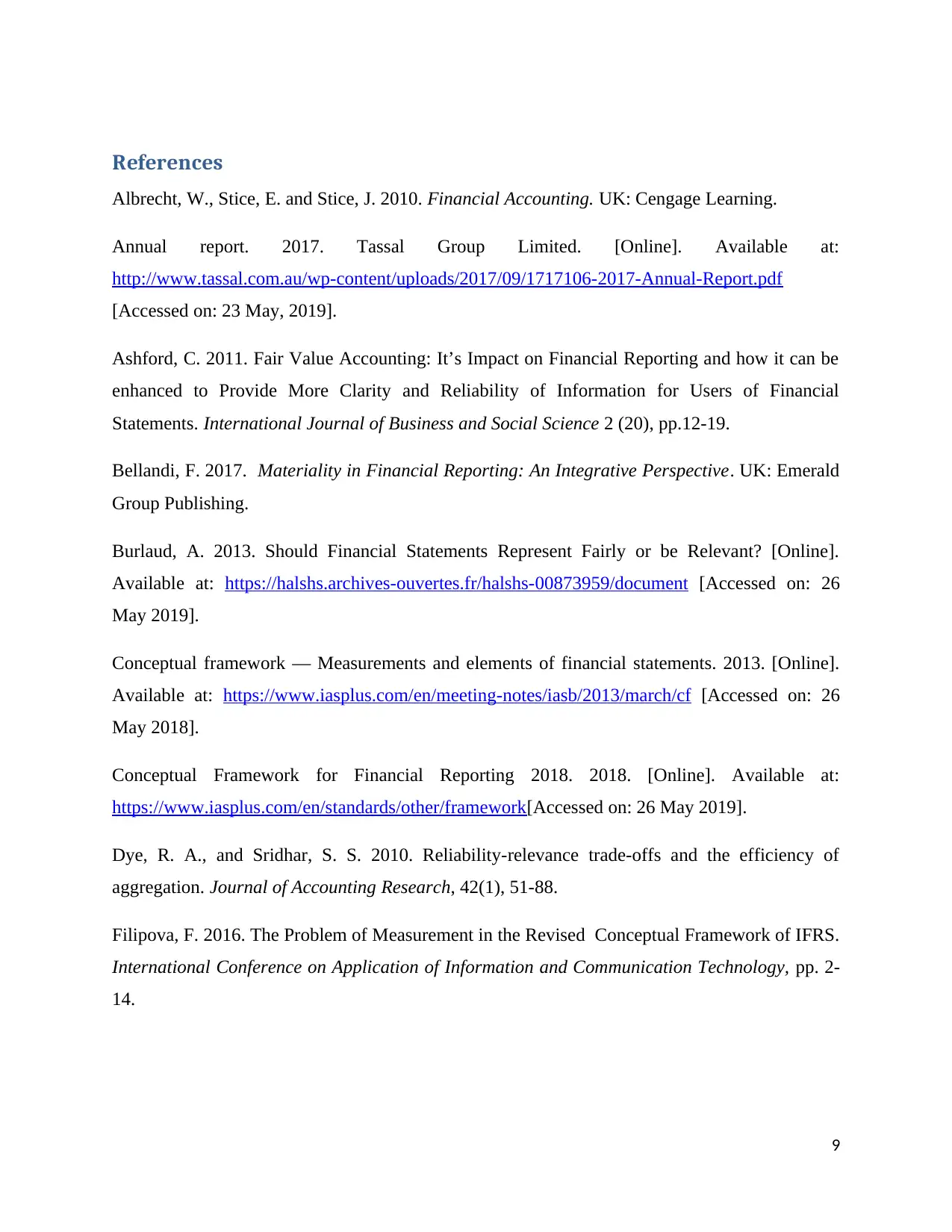
References
Albrecht, W., Stice, E. and Stice, J. 2010. Financial Accounting. UK: Cengage Learning.
Annual report. 2017. Tassal Group Limited. [Online]. Available at:
http://www.tassal.com.au/wp-content/uploads/2017/09/1717106-2017-Annual-Report.pdf
[Accessed on: 23 May, 2019].
Ashford, C. 2011. Fair Value Accounting: It’s Impact on Financial Reporting and how it can be
enhanced to Provide More Clarity and Reliability of Information for Users of Financial
Statements. International Journal of Business and Social Science 2 (20), pp.12-19.
Bellandi, F. 2017. Materiality in Financial Reporting: An Integrative Perspective. UK: Emerald
Group Publishing.
Burlaud, A. 2013. Should Financial Statements Represent Fairly or be Relevant? [Online].
Available at: https://halshs.archives-ouvertes.fr/halshs-00873959/document [Accessed on: 26
May 2019].
Conceptual framework — Measurements and elements of financial statements. 2013. [Online].
Available at: https://www.iasplus.com/en/meeting-notes/iasb/2013/march/cf [Accessed on: 26
May 2018].
Conceptual Framework for Financial Reporting 2018. 2018. [Online]. Available at:
https://www.iasplus.com/en/standards/other/framework[Accessed on: 26 May 2019].
Dye, R. A., and Sridhar, S. S. 2010. Reliability-relevance trade-offs and the efficiency of
aggregation. Journal of Accounting Research, 42(1), 51-88.
Filipova, F. 2016. The Problem of Measurement in the Revised Conceptual Framework of IFRS.
International Conference on Application of Information and Communication Technology, pp. 2-
14.
9
Albrecht, W., Stice, E. and Stice, J. 2010. Financial Accounting. UK: Cengage Learning.
Annual report. 2017. Tassal Group Limited. [Online]. Available at:
http://www.tassal.com.au/wp-content/uploads/2017/09/1717106-2017-Annual-Report.pdf
[Accessed on: 23 May, 2019].
Ashford, C. 2011. Fair Value Accounting: It’s Impact on Financial Reporting and how it can be
enhanced to Provide More Clarity and Reliability of Information for Users of Financial
Statements. International Journal of Business and Social Science 2 (20), pp.12-19.
Bellandi, F. 2017. Materiality in Financial Reporting: An Integrative Perspective. UK: Emerald
Group Publishing.
Burlaud, A. 2013. Should Financial Statements Represent Fairly or be Relevant? [Online].
Available at: https://halshs.archives-ouvertes.fr/halshs-00873959/document [Accessed on: 26
May 2019].
Conceptual framework — Measurements and elements of financial statements. 2013. [Online].
Available at: https://www.iasplus.com/en/meeting-notes/iasb/2013/march/cf [Accessed on: 26
May 2018].
Conceptual Framework for Financial Reporting 2018. 2018. [Online]. Available at:
https://www.iasplus.com/en/standards/other/framework[Accessed on: 26 May 2019].
Dye, R. A., and Sridhar, S. S. 2010. Reliability-relevance trade-offs and the efficiency of
aggregation. Journal of Accounting Research, 42(1), 51-88.
Filipova, F. 2016. The Problem of Measurement in the Revised Conceptual Framework of IFRS.
International Conference on Application of Information and Communication Technology, pp. 2-
14.
9
⊘ This is a preview!⊘
Do you want full access?
Subscribe today to unlock all pages.

Trusted by 1+ million students worldwide
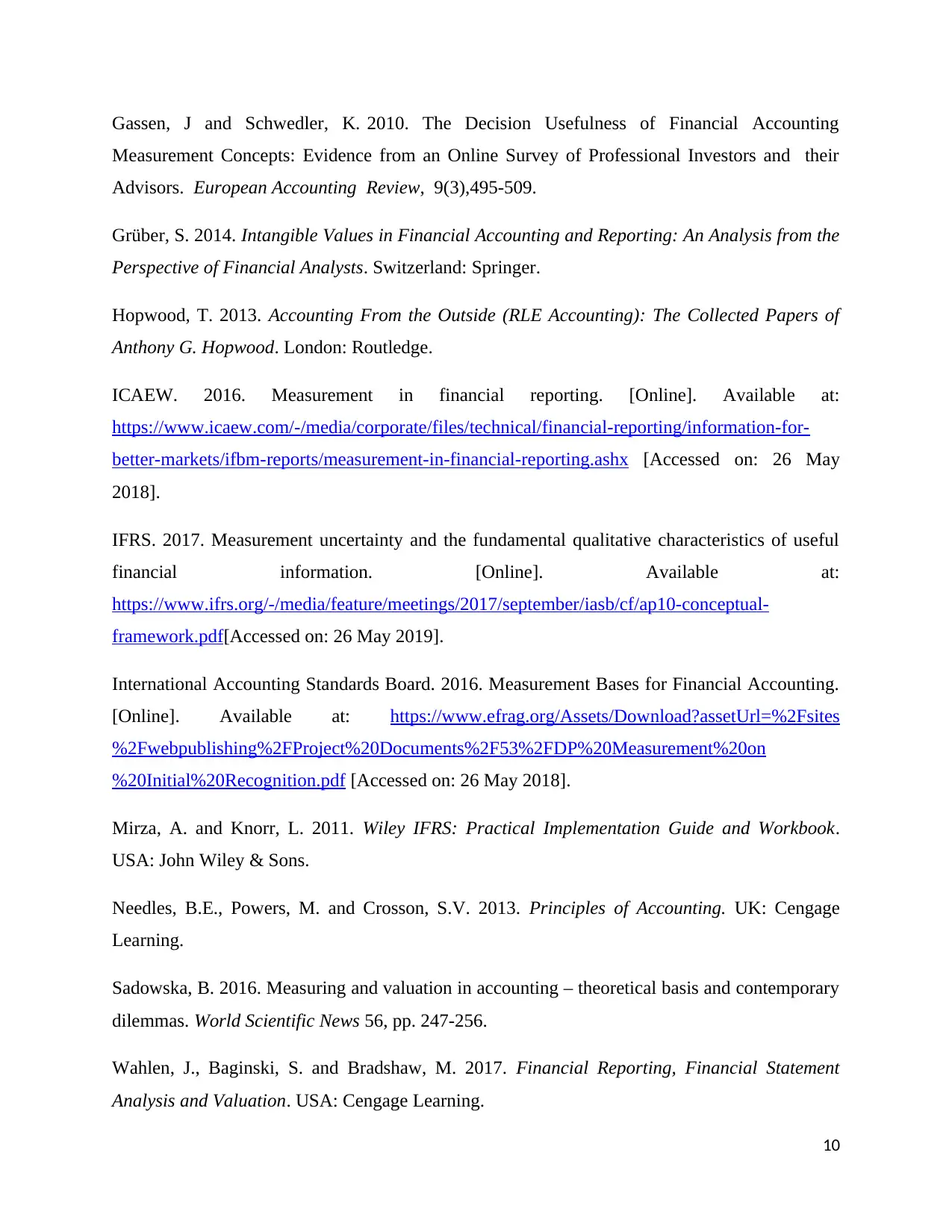
Gassen, J and Schwedler, K. 2010. The Decision Usefulness of Financial Accounting
Measurement Concepts: Evidence from an Online Survey of Professional Investors and their
Advisors. European Accounting Review, 9(3),495-509.
Grüber, S. 2014. Intangible Values in Financial Accounting and Reporting: An Analysis from the
Perspective of Financial Analysts. Switzerland: Springer.
Hopwood, T. 2013. Accounting From the Outside (RLE Accounting): The Collected Papers of
Anthony G. Hopwood. London: Routledge.
ICAEW. 2016. Measurement in financial reporting. [Online]. Available at:
https://www.icaew.com/-/media/corporate/files/technical/financial-reporting/information-for-
better-markets/ifbm-reports/measurement-in-financial-reporting.ashx [Accessed on: 26 May
2018].
IFRS. 2017. Measurement uncertainty and the fundamental qualitative characteristics of useful
financial information. [Online]. Available at:
https://www.ifrs.org/-/media/feature/meetings/2017/september/iasb/cf/ap10-conceptual-
framework.pdf[Accessed on: 26 May 2019].
International Accounting Standards Board. 2016. Measurement Bases for Financial Accounting.
[Online]. Available at: https://www.efrag.org/Assets/Download?assetUrl=%2Fsites
%2Fwebpublishing%2FProject%20Documents%2F53%2FDP%20Measurement%20on
%20Initial%20Recognition.pdf [Accessed on: 26 May 2018].
Mirza, A. and Knorr, L. 2011. Wiley IFRS: Practical Implementation Guide and Workbook.
USA: John Wiley & Sons.
Needles, B.E., Powers, M. and Crosson, S.V. 2013. Principles of Accounting. UK: Cengage
Learning.
Sadowska, B. 2016. Measuring and valuation in accounting – theoretical basis and contemporary
dilemmas. World Scientific News 56, pp. 247-256.
Wahlen, J., Baginski, S. and Bradshaw, M. 2017. Financial Reporting, Financial Statement
Analysis and Valuation. USA: Cengage Learning.
10
Measurement Concepts: Evidence from an Online Survey of Professional Investors and their
Advisors. European Accounting Review, 9(3),495-509.
Grüber, S. 2014. Intangible Values in Financial Accounting and Reporting: An Analysis from the
Perspective of Financial Analysts. Switzerland: Springer.
Hopwood, T. 2013. Accounting From the Outside (RLE Accounting): The Collected Papers of
Anthony G. Hopwood. London: Routledge.
ICAEW. 2016. Measurement in financial reporting. [Online]. Available at:
https://www.icaew.com/-/media/corporate/files/technical/financial-reporting/information-for-
better-markets/ifbm-reports/measurement-in-financial-reporting.ashx [Accessed on: 26 May
2018].
IFRS. 2017. Measurement uncertainty and the fundamental qualitative characteristics of useful
financial information. [Online]. Available at:
https://www.ifrs.org/-/media/feature/meetings/2017/september/iasb/cf/ap10-conceptual-
framework.pdf[Accessed on: 26 May 2019].
International Accounting Standards Board. 2016. Measurement Bases for Financial Accounting.
[Online]. Available at: https://www.efrag.org/Assets/Download?assetUrl=%2Fsites
%2Fwebpublishing%2FProject%20Documents%2F53%2FDP%20Measurement%20on
%20Initial%20Recognition.pdf [Accessed on: 26 May 2018].
Mirza, A. and Knorr, L. 2011. Wiley IFRS: Practical Implementation Guide and Workbook.
USA: John Wiley & Sons.
Needles, B.E., Powers, M. and Crosson, S.V. 2013. Principles of Accounting. UK: Cengage
Learning.
Sadowska, B. 2016. Measuring and valuation in accounting – theoretical basis and contemporary
dilemmas. World Scientific News 56, pp. 247-256.
Wahlen, J., Baginski, S. and Bradshaw, M. 2017. Financial Reporting, Financial Statement
Analysis and Valuation. USA: Cengage Learning.
10
Paraphrase This Document
Need a fresh take? Get an instant paraphrase of this document with our AI Paraphraser

11
1 out of 11
Related Documents
Your All-in-One AI-Powered Toolkit for Academic Success.
+13062052269
info@desklib.com
Available 24*7 on WhatsApp / Email
![[object Object]](/_next/static/media/star-bottom.7253800d.svg)
Unlock your academic potential
Copyright © 2020–2025 A2Z Services. All Rights Reserved. Developed and managed by ZUCOL.





